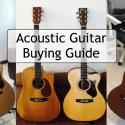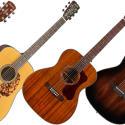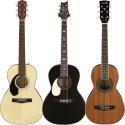What Is A Dreadnought Guitar? The Ultimate Guide
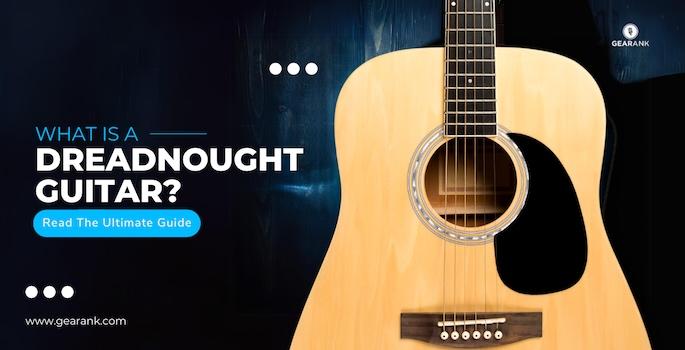
There are many different acoustic guitar body shapes on the market, but the dreadnought reigns as the most popular.
Used by many iconic guitarists, it is the shape that comes to mind when visualizing an acoustic guitar.
Let's look at what sets dreadnoughts apart from other acoustic guitars. Uncover the reasons behind their widespread popularity.
In this article, you'll learn
-
What is a Dreadnought Guitar?
-
Dreadnought Guitar vs Other Guitars
-
Characteristics of Dreadnought Guitars
-
Is A Dreadnought For You?
-
Popular Dreadnought Guitar Models and Artists
To begin, let's learn about its origin.
What is a Dreadnought Guitar?
The term dreadnought originally refered to a warship. This dreadnought guitar was named after a World War I British Battleship named HMS Dreadnought. With a length of 527 feet and displacing 18,000 tons, it was one of the biggest ships to sail.
But why is it named after a big ship? When this guitar body shape was developed, C.F. Martin wanted to give it a name that demonstrated its enormous size. So, they named it after the HMS Dreadnought.
In 1916, the first dreadnought guitar was made by C.F. Martin and Company for a retail company named Oliver Ditson. However, the product was discontinued due to low sales.
After revising the design in 1931, the Martin Guitar Company began making them of rosewood and mahogany and branded them under their name. These dreadnought guitars quickly rose in demand. They have become widely used by folk or bluegrass musicians due to their signature sound and balanced tone.
Due to its immense popularity, the Gibson Guitar Company made a round-shouldered Jumbo acoustic guitar. This rivaled the classic dreadnought shape. Other manufacturers followed suit, making the dreadnought one of the most popular acoustic guitar styles today.
Traditional dreadnoughts have a square shoulder with a straight upper and bottom section. With its large body, the dreadnought style guitar gives a much richer, louder, and deeper tone than other guitars.
This loud projection and classic appeal continue to make dreadnought guitars the most popular guitar body type in the market.
Characteristics of Dreadnought Guitars
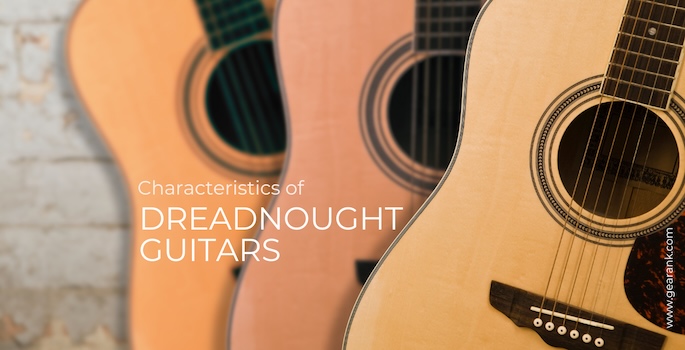
These guitars produce a robust, resonant, mid-range tone with significant volume. That is why dreadnought acoustic guitars are highly sought-after. It's also a dependable instrument, making it a favorite amongst musicians.
A standout feature of dreadnoughts is their ability to generate a loud, rich tone. This is due to their size and body design. They are also more suitable for percussive playing, flat-picking, and strumming. Frequently used in acoustic bands, they can serve as a rhythm instrument.
Speaking of guitar sizes, different manufacturers size their dreadnoughts slightly different. But on average, dreadnoughts follow the specs of a Martin dreadnought. This means that the dimensions of the dreadnought body will be within the following specs:
| BODY LENGTH | 20" |
| UPPER BOUT WIDTH | 11.5" |
| LOWER BOUT WIDTH | 15.625" |
| UPPER BOUT DEPTH | 3.94" |
| LOWER BOUT DEPTH | 4.875" |
Playability
Due to their versatility, dreadnoughts are often the popular choice among acoustic guitarists. They fit well in various musical settings, whether as part of a band or accompanying singers. These guitars can also accommodate multiple playing techniques. From strumming to Fingerpicking, it can also be used for fingerstyle.
Regarding sound quality, dreadnoughts are recognized for their distinct loud sound. A well-pronounced mid-range complements a robust bass tone. This makes them a favored choice for singer-songwriters and performers as accompaniment.
Physical Aspects
Their broad waistline gives them a more square appearance. This differs from the smoother, rounder shapes of other guitars.
Traditional dreadnought guitar bodies have a solid spruce top and mahogany for the back and sides. This can very depending on the model and maker.
The neck of the dreadnought guitar usually cuts off at the 14th fret. This allows players to reach higher notes and create varied chords.
Popular Dreadnought Guitar Models
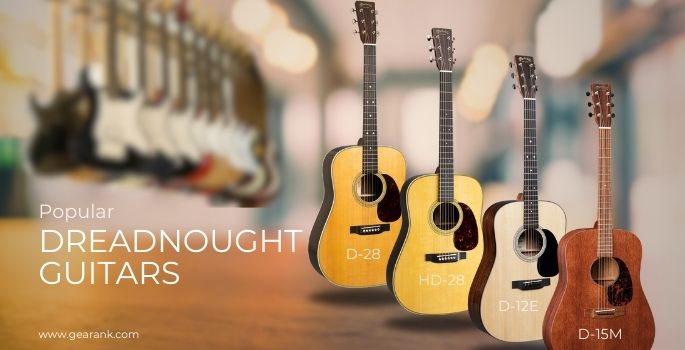
The D-28 is among the most renowned dreadnought guitars, famously associated with folk musicians like Johnny Cash. It is said that he used 2 of them in the last 30 years of his career and life.
Martin continues to produce a range of dreadnought models in different price ranges. This includes: HD-28, Martin D-12E and D-15M.
Martin guitars are some of the most expensive acoustic guitars and are known for their quality and craftsmanship. They are also known for using premium tonewoods, with high endmodels sporting a rosewood bridge, fretboard, back, and sides.
Cost-effective alternatives are available, like the Fender's CD-60S,Yamaha's FG800, and similar guitars.
Popular Dreadnought Guitar Players
Notable musicians who used dreadnought guitars include Eric Clapton, Kurt Cobain, and others. These musicians used the dreadnought for studio and live performances. This further cements its position as one of the most preferred acoustic guitar types.
Dreadnought Guitar vs Other Guitars
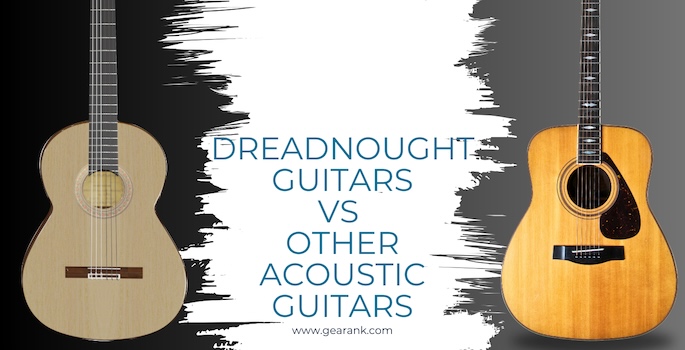
Its broad body and less defined waist is the most identifiable feature of a dreadnought guitar. This design also inspired a lot of acoustic guitars, making it one of the most popular body shapes.
Aside from its shape, we also know that a dreadnought produces a resonant and powerful sound thanks to its large body.
But other than guitar body shapes what sets it apart from other guitars? Here are some of the most common acoustic guitar shapes today.
-
Classical Guitars vs Dreadnought Guitars
Compared to a dreadnought, a classical guitar notably has a smaller body. This compact size offers a balanced sound with a more focused mid-range. But Dreadnought guitars will have a louder tone, deeper bass response, and crisper treble. Another main difference between the two is string material. Classical guitars are equipped with nylon strings, while dreadnoughts have steel strings.
-
Concert Guitars vs Dreadnought Guitars
In terms of shape, concert acoustic guitars have a noticeable slimmer waist compared to a dreadnought. In terms of sound, while a dreadnought acoustic guitar is suited for ensemble playing, a concert guitar is better suited for solo playing. It offers a more concentrated and focused sound, which is suitable for individual performances.
-
Grand Auditorium Guitars vs Dreadnought Guitars
A dreadnought guitar is used mainly for strumming because of its deeper, more bass-rich tone. A grand auditorium guitar, on the other hand, is used primarily for fingerstyle playing. This can be attributed to its smaller waist and rounder shape.
-
Jumbo Guitars vs Dreadnought Guitars
In contrast to a dreadnought's square-like shape, a jumbo acoustic guitar has a rounder shape. Because of this, jumbo guitars have a stronger bass.
A jumbo guitar has rich, resonant notes, ideal for blues, jazz, and even rock.
-
Parlor Guitars vs Dreadnought Guitars
A parlor guitar has a compact, portable, and easy to handle design. In addition, it also has a gentler and more mellow tone in contrast with the more robust tone of a dreadnought guitar. Making parlor guitar perfect for blues playing style.
Is A Dreadnought For You?

Are you looking to get a new guitar and wondering if a dreadnought is good for you're particular playing style?
If you want a bold and rich tone, or if you're someone who likes strumming and fingerstyle techniques, then you will appreciate a dreadnought.
Its potent sound caters well to singer-songwriters and folk bands.
Just be wary of its bigger size and deep body, which can make it challenging to play.
Ultimately, it will boil down to personal preference. Dreadnought guitars are quite flexible in terms of tone and projection, so it can easily fit into different styles and tones.
Final Thoughts
Now it's clear to you what is a dreadnought guitar. Its bold guitar body shape inspired a whole generation of acoustic guitars.
This instrument design, initially crafted by C.F. Martin and Company in 1916, is still famous. It serves a wide range of musical needs and preferences.
It is a true testament to the dreadnought's timeless quality and has cemented its place in music as an excellent instrument suited for aspiring musicians and pros.
If you're looking for a workhorse acoustic guitar with good projection, the dreadnought shape should be the first on your list.
Frequently Asked Questions
Is a Dreadnought Guitar Good for Beginners?
Dreadnought guitars have a large body that can be challenging for a beginner guitar player, especially for children.
The bulky dreadnought shape can initially feel awkward, but in time, students will get accustomed to it. Some of my younger students started out with dreadnoughts without much of an issue. One popular beginner acoustic is the Fender CD-60SCE dreadnought guitar, it has rolled fingerboard edges and a cutaway, which makes for easy your playing.
But if comfort is important, or you want to encourage a hesitant student, then you can go for smaller bodied acoustics. There are models made specifically for kids, like a downsized ¾ scale dreadnought acoustic guitar. This smaller body design are easier for small children to play.
Is My Acoustic Guitar a Dreadnought?
As mentioned earlier, one of the most distinguishable features of dreadnought acoustic guitar is its size and shape. It has a large body and lower bout, square shoulders, with a waist that is not very defined. The 14th fret of a dreadnought guitar is generally where the neck joint is located.
Can I Plug My Dreadnought Acoustic Guitar Into a Speaker?
Only if it's an electro-acoustic guitar. Many dreadnought guitars today are acoustic-electric guitar models with built-in pickup and preamp systems. This enables you to play through an amp or speaker.
Some advanced models have preamps with tuners, volume, or tone control to provide tone-shaping. Most acoustic-electric guitars, have cutaway. So if you see a dreadnought with a cutaway near the neck, there is a high probability that it is an acoustic-electric model.
Contributors:
Jerome Arcon - Co-writer
Jerry Borillo - Illustrator




